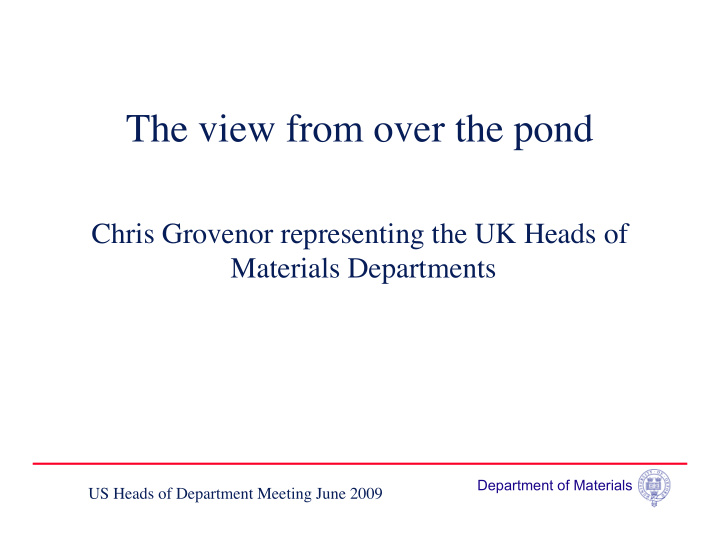



The view from over the pond Chris Grovenor representing the UK Heads of Materials Departments Department of Materials US Heads of Department Meeting June 2009
Graduate intake/Staff FTE Graduate intake pa Full time equivalent staff 30-40 25 Cambridge 60 Mat Science – 27, Corrosion – 10 Manchester Textiles + Paper - 26 Leeds 15 11 Swansea 40 14 Loughborough 50 18 Imperial College 40 33 Oxford 30 22 Birmingham 40+ 25 Liverpool 15 10 South Bank ? 18 Department of Materials US Heads of Department Meeting June 2009
Undergraduate intake 650 students admitted each year to read Natural Sciences. Cambridge Present numbers: Year 1 185; Year 2 50; Years 3/4 18 45 for Materials Science and Engineering + Biomedical Manchester Materials Science 180 for Textiles based programmes. Leeds Now concentrating on MSc and M.Eng Swansea 20 Loughborough 65-70 Imperial College 85 Oxford 30 Birmingham 25? South Bank 80+ in first year, 20+ in 3 rd /4 th years Department of Materials US Heads of Department Meeting June 2009
Research funding Annual funding 2008 Industry/Research Council/EU £8m 29% 58% 13% Cambridge £6m 10% 80% 10% Manchester Leeds £1.7m - Swansea - £1.3 10% 80% 10% Loughborough £2m Imperial College 20% 60% 20% £3-4m Oxford 25% 60% 15% £6m Department of Materials US Heads of Department Meeting June 2009
Significant developments UK Research Assessment Exercise in 2008 • 20 ‘units’ assessed • performance overall in line with Chemistry and Engineering • Cambridge, Manchester, Liverpool and Oxford were top 4 • Metallurgy and biomaterials scored well, ceramics less so UK Centre for Materials Education – 2008 National Subject Profile on Materials as an undergraduate subject. http://www.materials.ac.uk/index.asp http://www.materials.ac.uk/subject-profile/report.asp • U/G population holding steady at about 400-500 pa • New demographic developing of 30%+ non-EU students • external (especially financial) pressures felt by students • increased admin. burden of changes in quality assurance procedures • adapting to the changing academic background of student population. Department of Materials US Heads of Department Meeting June 2009
Contribution to other programmes and Masters Many materials departments contribute to teaching in other faculties. Bath and Loughborough in Sports Science Leeds new B.Eng/M.Eng in Materials Science and Eng. MSc or not? Not all the large departments operate MSc programmes. There is significant debate as to whether they are money-making or not. • For instance, Manchester has 3 taught MScs in Polymer Mat Sci Eng, Adv Eng Materials and Textiles with a total of 70 students a year • Cambridge have one MSc in Nanomaterials with 20 • Oxford does not offer an MSc programme Department of Materials US Heads of Department Meeting June 2009
Major Issues Difficult to attract industrial funding and low overhead recovery rate on industrial funding --issues heightened by the recession Difficulties in recruiting U/Gs - could ultimately could threaten the survival of independent u/g programme. Over dependence on overseas (Asian) students Closure/merging of independent Materials Departments in UK (worldwide problem?) “Full Economic Costing” – but funded at only 80% Impact of reorganisation of EPSRC on Materials. Department of Materials US Heads of Department Meeting June 2009
Research Strategies Major change in UK scene, with much more emphasis on large integrated projects rather than one PI/one postdoc grants. • EPSRC has moved towards funding multisite/multi PI grants (Programme /Platform) at between £1-6m. Relationships with other departments /institutions/disciplines increasingly critical. • EU funding has always been of this type – large collaborative programmes with up to 50 partners Department of Materials US Heads of Department Meeting June 2009
Research Strategies II US/UK collaboration. Seen in the UK as a field in which more could be done • The 2006 Roberts report made some interesting statements about the value of transatlantic collaboration. http://www.wolfson.ox.ac.uk/UK-US-Academic-Collaboration/GarethRobertsIPoREx.pdf • Recently the “double jeopardy” problem with joint EPSRC/NSF applications has been removed Department of Materials US Heads of Department Meeting June 2009
Research Strategies III US/UK collaboration. • citations for co-authored papers 2-3 times higher than papers with only US or only UK authors Department of Materials US Heads of Department Meeting June 2009
Recommend
More recommend